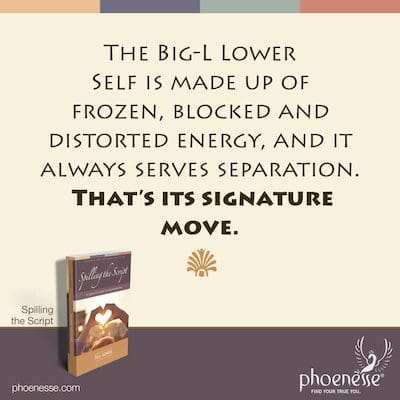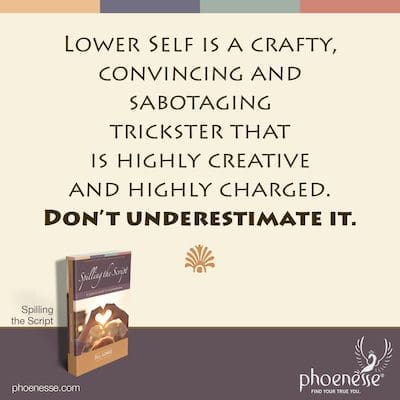
At some point in this work, we will find the place that really doesn’t want to change—that doesn’t want to give up negativity. This is the Big-L Lower Self. It is made up of frozen, blocked and distorted energy, so it vibrates at a lower frequency than Higher Self energy, and it’s holding onto a great big No to life.
In this part of ourselves, we actually sort of like our faults. Further, the Lower Self has the capacity to inflict cruelty on ourselves and others: “I’ll hurt you and I’ll hurt me.” This cruelty is the main reason we try to escape ourselves. We need to find the pleasure in our destructiveness if we hope to tame this beast.
In retaliation for having our desire for 100% perfect love rejected, our Lower Self now demands love. But it refuses to give anything, digging in its heels and saying, “I won’t,” or more specifically, “I won’t give and I won’t ever give in.” This is the underlying basis of our Lower Self’s negative intention to stay stuck.
Further, our Lower Self intends to have its way without paying any price for it. We might call this “self-will run riot.” Plus we refuse to let our parents off the hook for the pain they caused and the humiliation that went with it. This fear of humiliation underpins many of the fears of our Lower Self.
To cap things off, we compensate for our hidden feelings of inferiority by attempting to prove we are better than others; we face the world in a spirit of competitiveness. Then we build cases against others, gossiping and maligning them in an effort to take them down. All of this is pride.

Through the combination of these three main faults of self-will, fear and pride—all other faults cascade from these three—the Lower Self always serves separation instead of connection; separation, in fact, is the Lower Self’s signature move. And because it is a trickster, our Lower Self manages to hide its childish attempts at defending against further pain behind a mask—a Power Mask, a Love Mask or a Serenity Mask—all of which are ineffective strategies certain to sabotage any chance for real connection. In this way, our Lower Self hires our mask to do its dirty work.
In addition to holding back, the Lower Self will also betray others or hurt them by seducing and rejecting them. When the resulting vicious circles lead to more pain and nonfulfillment, the Lower Self will judge others in an effort to avoid feeling affected. This traps us in feeling like we’re a victim, causing us to circle back and shore up our mask.
Early down the path to self-knowing, we need to become willing to take off our mask because our mask is not real; it’s just a strategy for avoiding “death”—or in other words, pain—and for hiding ourselves. Our fear is that without our mask, this Lower Self is what others will see. Worse yet, we fear that this is who we really are.
First, we need to remember that behind the Lower Self is our Higher Self yearning to shine freely. Second, it is important to learn how to expose these dark aspects without acting them out. That said, when we see these darker places in others, we often find it easier to connect with them and accept them than when we are only allowed to see their mask. The Lower Self may be unpleasant, but at least it is real.

One of the most common pitfalls that happens when we start doing this work of self-discovery is we begin to see with much greater clarity the many ways in which we fall short. And then we turn the flashlight we have been holding into a club and start to attack ourselves with it. The Pathwork Guide cautions us to watch for this and to call a halt to it when we see. It doesn’t help, and makes following a difficult path even more challenging.
The source of this voice is the inner critic. It is a perpetual little tyrant that continually and silently beats us up, and now intends to make us stop exploring. We know that it comes from the Lower Self because it serves to keep us separate from our own self. Until we slow down and get quiet, we may have no idea what kind of cruel things this unkind inner voice has been saying to us.
When we start doing this work of self-discovery, we often turn our flashlight into a club and start to attack ourselves with it.
Here is how the inner critic gets created. When the child did not receive the perfect love it craved, conclusions were drawn such as “I can’t be loved as I am,” “They’ll never love me,” or “I can’t succeed.” These conclusions are unique to each person, and at the same time, they are all the same. They basically say, “I’m worthless, I don’t matter, I’m not enough,” making the child feel inferior. This creates deep resentment for which a fear of punishment builds up.
At about the age of six, a child can project into the future. The child begins to anticipate the parents, and based on these wrong conclusions, chooses a defense intended to save it from ever being hurt again.
As the child grows, this defensive behavior becomes a habit, and the conclusions that drive it sink into the unconscious. From there, they have the power to create, and they create nothing but problems.
At about the age of seven, the Big-L Lower Self creeps in and starts attacking—or punishing—the self. It is the internalized voice of a parent, and it uses the wrong conclusions of the child to justify itself: “You’re worthless, who do you think you are,” or “They’ll never love you, why do you keep trying,” or “You’re a loser, you’ll never succeed.” The specifics will vary for each person, but the harsh tone will be the same.
This inner critic—or really, inner tyrant or tormentor—is a perpetrator of cruelty to the self and it needs to be unmasked. When we won’t see it inside us, we will turn it on others and become a bully. Or we will attract bullies to us, and we will see it there. Where there is a victim, there is also a victimizer.
Don’t underestimate the Lower Self. As brilliant and amazing as our Higher Self is, that’s how “good” our Lower Self is. It is a crafty, convincing and sabotaging trickster that is highly creative and highly charged.

As a negative creator, it will undermine our good intentions, cleverly setting others up to behave in a way that confirms our negative beliefs. For example, the Lower Self might take the idea “I’m inferior” and use it to undermine our ability to express ourselves clearly. When we realize we’re being inarticulate or babbling, we actually feel inferior, confirming our belief. We may then turn around and judge the one we’re talking to as being uncaring because they lost interest in what we were saying. The Lower Self may then lash out, to “get them back”, perhaps by ignoring them or sulking. But we set the whole thing up due to our misunderstanding that we’re somehow inferior.
To unwind all of this, we need to get to know ourselves better, including our Lower Self.
What we need to realize is that these hidden parts of ourselves are immature, but that doesn’t make us bad. Often, in our childlike enthusiasm, we trip over these undeveloped aspects that don’t yet know how to pace themselves, causing us to stop our flow in life, fabricate stories and manufacture walls. To unwind all of this, we need to get to know ourselves better, and that includes getting to know our own Lower Self.
We know that whatever we fight against gets stronger, so we want to dismantle the Lower Self slowly, step by step. It cannot be transformed by harshly judging it, or by judging ourselves for being caught in its tentacles. In doing that, we get further tangled in its web and the knots get tighter.
Instead, we need to expose the script the Lower Self is following. Awareness and acceptance are what’s needed here for healing. Once we see the damage we are doing to ourselves, we can wake up from the trance and snap out of it.
Return to Spilling the Script Contents


